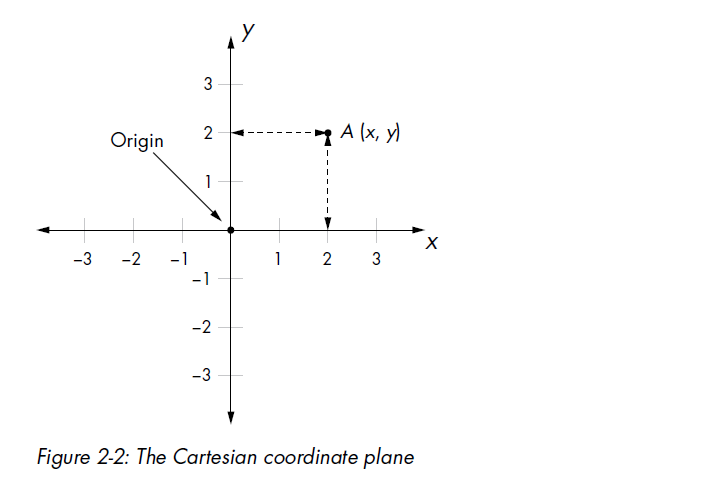chapter 2: visualizing Data with Graphs¶
이 장에서는 다양한 데이터를 mathplotlib를 통해 표현하는 방법을 배우도록 하겠다.
2.1 Understanding the Cartesian Coordinate Plane¶
다음처럼 숫자가 새겨진 라인을 생각해 보자.

아래는 Cartesian coordinate plane 을 나타낸다.

Working with Lists and Tuples¶
그래프를 그릴때 list,tuple을 많이 사용하게 될것이다.
Iterating over a List or Tuple¶
>>> l = [1, 2, 3]
>>> for item in l:
print(item)
>>> l = [1, 2, 3]
>>> for index, item in enumerate(l):
print(index, item)
Creating Graphs with Matplotlib¶
>>> x_numbers = [1, 2, 3]
>>> y_numbers = [2, 4, 6]
>>> from pylab import plot, show
>>> plot(x_numbers, y_numbers)
[<matplotlib.lines.Line2D object at 0x7f83ac60df10>]
plot(x_numbers, y_numbers, marker='o')
plot(x_numbers, y_numbers, 'o')
Graphing the Average Annual Temperature in New York City¶
from pylab import plot, show
nyc_temp = [53.9, 56.3, 56.4, 53.4, 54.5, 55.8, 56.8, 55.0, 55.3, 54.0, 56.7, 56.4, 57.3]
years = range(2000, 2013)
#plot(nyc_temp, marker='o')
years = range(2000, 2013)
plot(years, nyc_temp, marker='o')
show()
Comparing the Monthly Temperature Trends of New York City¶
from pylab import plot,show
from pylab import legend
legend([2000, 2006, 2012])
nyc_temp_2000 = [31.3, 37.3, 47.2, 51.0, 63.5, 71.3, 72.3, 72.7, 66.0, 57.0, 45.3, 31.1]
nyc_temp_2006 = [40.9, 35.7, 43.1, 55.7, 63.1, 71.0, 77.9, 75.8, 66.6, 56.2, 51.9, 43.6]
nyc_temp_2012 = [37.3, 40.9, 50.9, 54.8, 65.1, 71.0, 78.8, 76.7, 68.8, 58.0, 43.9, 41.5]
months = range(1, 13)
#plot(months, nyc_temp_2000, months, nyc_temp_2006, months, nyc_temp_2012)
#===============================================================================
# plot(months, nyc_temp_2000)
# plot(months, nyc_temp_2006)
# plot(months, nyc_temp_2012)
#===============================================================================
plot(months, nyc_temp_2000, months, nyc_temp_2006, months, nyc_temp_2012)
show()
Customizing Graphs¶
Adding a Title and Labels¶
from pylab import plot, show, title, xlabel, ylabel, legend
months = range(1, 13)
nyc_temp_2000 = [31.3, 37.3, 47.2, 51.0, 63.5, 71.3, 72.3, 72.7, 66.0, 57.0, 45.3, 31.1]
nyc_temp_2006 = [40.9, 35.7, 43.1, 55.7, 63.1, 71.0, 77.9, 75.8, 66.6, 56.2, 51.9, 43.6]
nyc_temp_2012 = [37.3, 40.9, 50.9, 54.8, 65.1, 71.0, 78.8, 76.7, 68.8, 58.0, 43.9, 41.5]
plot(months, nyc_temp_2000, months, nyc_temp_2006, months, nyc_temp_2012)
title('Average monthly temperature in NYC')
xlabel('Month')
ylabel('Temperature')
legend([2000, 2006, 2012])
show()
Customizing the Axes¶
from pylab import plot, show, axis
nyc_temp = [53.9, 56.3, 56.4, 53.4, 54.5, 55.8, 56.8, 55.0, 55.3, 54.0, 56.7, 56.4, 57.3]
plot(nyc_temp, marker='o')
print(axis())
axis(ymin=0)
show()
Plotting Using pyplot¶
'''
Simple plot using pyplot
'''
import matplotlib.pyplot
def create_graph():
x_numbers = [1, 2, 3]
y_numbers = [2, 4, 6]
matplotlib.pyplot.plot(x_numbers, y_numbers)
matplotlib.pyplot.show()
if __name__ == '__main__':
create_graph()
Saving the Plots
from pylab import plot, savefig
x = [1, 2, 3]
y = [2, 4, 6]
plot(x, y)
savefig('mygraph.png')
#savefig('C:\mygraph.png')
Plotting with Formulas¶
Newton’s Law of Universal Gravitation¶
Newton’s law of universal gravitation

'''
The relationship between gravitational force and
distance between two bodies
'''
import matplotlib.pyplot as plt
# Draw the graph
def draw_graph(x, y):
plt.plot(x, y, marker='o')
plt.xlabel('Distance in meters')
plt.ylabel('Gravitational force in newtons')
plt.title('Gravitational force and distance')
plt.show()
def generate_F_r():
# Generate values for r
r = range(100, 1001, 50)
# Empty list to store the calculated values of F
F = []
# Constant, G
G = 6.674*(10**-11)
# Two masses
m1 = 0.5
m2 = 1.5
# Calculate force and add it to the list, F
for dist in r:
force = G*(m1*m2)/(dist**2)
F.append(force)
# Call the draw_graph function
draw_graph(r, F)
if __name__=='__main__':
generate_F_r()

Generating Equally Spaced Floating Point Numbers¶
'''
Generate equally spaced floating point
numbers between two given values
'''
def frange(start, final, increment):
numbers = []
while start < final:
numbers.append(start)
start = start + increment
return numbers
Drawing the Trajectory¶
'''
Draw the trajectory of a body in projectile motion
'''
from matplotlib import pyplot as plt
import math
def draw_graph(x, y):
plt.plot(x, y)
plt.xlabel('x-coordinate')
plt.ylabel('y-coordinate')
plt.title('Projectile motion of a ball')
def frange(start, final, interval):
numbers = []
while start < final:
numbers.append(start)
start = start + interval
return numbers
def draw_trajectory(u, theta):
theta = math.radians(theta)
g = 9.8
# Time of flight
t_flight = 2*u*math.sin(theta)/g
# Find time intervals
intervals = frange(0, t_flight, 0.001)
# List of x and y coordinates
x = []
y = []
for t in intervals:
x.append(u*math.cos(theta)*t)
y.append(u*math.sin(theta)*t - 0.5*g*t*t)
draw_graph(x, y)
if __name__ == '__main__':
try:
u = float(input('Enter the initial velocity (m/s): '))
theta = float(input('Enter the angle of projection (degrees): '))
except ValueError:
print('You entered an invalid input')
else:
draw_trajectory(u, theta)
plt.show()
Comparing the Trajectory at Different Initial Velocities¶
'''
Draw the trajectory of a body in projectile motion
'''
from matplotlib import pyplot as plt
import math
def draw_graph(x, y):
plt.plot(x, y)
plt.xlabel('x-coordinate')
plt.ylabel('y-coordinate')
plt.title('Projectile motion of a ball')
def frange(start, final, interval):
numbers = []
while start < final:
numbers.append(start)
start = start + interval
return numbers
def draw_trajectory(u, theta):
theta = math.radians(theta)
g = 9.8
# Time of flight
t_flight = 2*u*math.sin(theta)/g
# Find time intervals
intervals = frange(0, t_flight, 0.001)
# List of x and y coordinates
x = []
y = []
for t in intervals:
x.append(u*math.cos(theta)*t)
y.append(u*math.sin(theta)*t - 0.5*g*t*t)
draw_graph(x, y)
if __name__ == '__main__':
# List of three different initial velocities
u_list = [20, 40, 60]
theta = 45
for u in u_list:
draw_trajectory(u, theta)
# Add a legend and show the graph
plt.legend(['20', '40', '60'])
plt.show()


